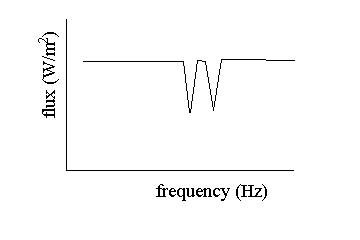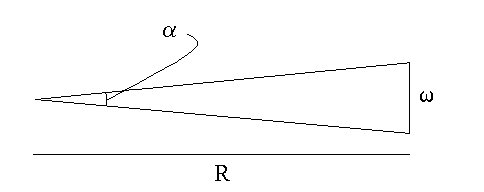BUCKNELL UNIVERSITY
Astronomy 102
First Hour Exam
|
1998 February 27
|
This Exam will be scored on a 100 point scale and has two parts:
a multiple choice section of 18 questions each worth 2 points
and a problem section with 3 problems, each worth 20 points.
You earn four points for writing your name on the exam.
Here are some quantities and relationships that you might find useful:
Multiple Choice Questions:
1) Water waves travel across the surface of a pond with a speed of 12 m/s. If the
waves lap up against the far shore at a rate of 3 per second, what is the wavelength
of the waves?
- a) 36 m
- b) 4 Hz
- c) 4 m
- d) 36 Hz
- e) 3 Hz
2) The chromospheric "flash" spectrum seen just before a total solar eclipse is an
example of
- a) blackbody emission
- b) spectral line absorption
- c) spectral line emission
- d) blackbody absorption
- e) thermal emission
3) The astronomer who correctly deduced that stars are composed mainly of
hydrogen was
- a) Henry Norris Russell
- b) Cecilia Payne
- c) Max Planck
- d) Henrietta Leavitt
- e) Annie Jump Cannon
4) The most convincing piece of evidence indicating that stars are really as
luminous as the Sun is
- a) stellar spectra are well-fit by a blackbody model.
- b) stars have colors similar to those of the Sun.
- c) stars have very small parallaxes.
- d) stars rise and set just like the Sun.
- e) the absorption seen in stellar spectra indicates that stars have chemical
compositions very similar to that of the Sun.
5) Photons with energies slightly lower than the energies of visible light photons are
- a) infrared photons.
- b) radio photons.
- c) ultraviolet photons.
- d) x-ray photons.
- e) photon torpedoes.
6) Rigel has an apparent magnitude of 0.1 and Polaris has an apparent magnitude of
2.1. What is the ratio of the fluxes from these two stars?
- a) 2.0
- b) 2.512
- c) 5.024
- d) 6.31
- e) 100
7) Which of the following spectral types corresponds to the hottest Main Sequence
stars?
8) Which of the following spectral types corresponds to the Main Sequence stars of
the lowest mass?
9) The temperature of an object is a measure of
- a) its total energy content.
- b) the average amount of energy per gram.
- c) the average amount of energy per particle.
- d) the total energy contained in the motions of all of the particles.
10) A star with a surface temperature of 6000 K will emit a blackbody spectrum
which peaks at what wavelength?
- a) 6000 m
- b) 5 x 10-7 nm
- c) 18 nm
- d) 5 x 10-7 m
- e) 1.8 x 10-7 nm

11) In the above sketch, the Bohr model of an atom is
represented with
a black nucleus and three acceptable electron orbits. If an electron
in this atom were initially in state 2 and moved to state 1, this
would result in
- a) the emission of a light photon whose energy is
equal to the energy of state 1.
- b) the absorption of a light photon whose energy is equal to the
difference in energy between states 1 and 2.
- c) the emission of a light photon
whose energy is equal to the difference in energy between states 1 and 2.
- d) the emission of a light photon whose energy is equal to the
energy of state 2.
- e) the absorption of a light photon whose energy is equal to the
energy of state 2.
12) Still referring to the above sketch, which electronic
transition would produce the shortest wavelength photon?
- a) the transition from state 2 to state 1
- b) the transition from state 3
to state 1
- c) the transition from state 3 to state 2
- d) the transition from state 1 to state 3
- e) the ionization of the electron from state 1
The following six questions refer to the Hertzsprung-Russell Diagram below:

13) Please indicate, by marking an "X" in the above diagram,
the position of the Sun.
14) Please write down the letter indicating the position of a
star on the Main Sequence (there are several correct answers; pick one)
D, C, E
15) Please write down the letter indicating the position of
White Dwarfs in this diagram A
16) Please write down the letter corresponding to the stars
with the largest radii in this diagram B
17) Please write down the letter corresponding to the stars
which would appear the most red if you were to look at them in the night sky
B,E
18) Of all of the lettered choices, find the most luminous
star. What is its surface temperature?
30000 K
Problems:
(Show your work!! I will be very generous with partial credit!!!)
Problem 1) A giant star of spectral type
M0 has a luminosity 300 times larger than a typical Main Sequence M0
star. A Main Sequence M0 star has a radius of 1.0 x 108 m.
Part 1) What is the ratio of the intensities of the two stars?
(5 points)
Solution
Part 2) What is the radius of the M0 giant?
(15 points)
Solution
Problem 2) Sirius is a
Main Sequence star with a surface temperature of 8000 K and a
luminosity of 8.61 x 1027 W. It has a parallax of 1.053 x
10-4 degrees.
Part 1) Calculate its distance.
(10 points)
Solution
Part 2) Calculate the flux (in W/m2) from
this star, when viewed from the Earth.
(10 points)
Solution
Problem 3) Stars alpha
gamma globulin and beta gamma globulin are members of an eclipsing
spectroscopic binary system. Both stars have the same mass and orbit
their common center of mass with velocity 3.0 x 105 m/s.
An optical spectrum of the light from the binary system shows the
following "w" shaped absorption line:

Part 1) Both absorption lines have been identified as due to the
transition from the N=2 to N=3 energy levels of the hydrogen atom. The
difference in energy between these two levels is 3.03 x 10-19
Joules. Calculate the rest frequency of the photons absorbed by this
process.
(10 points)
Solution
Part 2) Calculate the maximum frequency
separation between the two absorption lines in the above spectrum due
to the motions of the stars .
(10 points)
Solution



